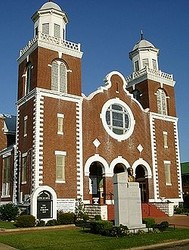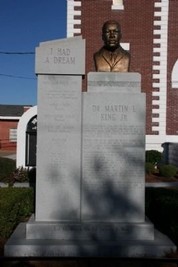Brown Chapel A.M.E. Church: "I Had A Dream" Historical Marker
Introduction
Text-to-speech Audio
Images
The Brown Chapel A.M.E. Church is the location where the March from Selma to Montgomery, AL began.

The "I Had a Dream" historical marker outside of the Browns Chapel AME Church symbolized the most important advancement in civil rights history and represents the efforts made to achieve equal voting rights for African Americans. At the top of the marker

Backstory and Context
Text-to-speech Audio
In 1965, Alabama was a very racially divided state. African Americans did not yet have equal voting rights and, therefore, planned a series of marches in Selma as part of the civil rights movement. Two marches took place prior to, perhaps, the most significant march from Selma to Montgomery. The march began on March 21st, lasted 5 days (March 21-March 25), extended for 54 miles, and comprised of roughly 3,200 people. At the heart of this march was Martin Luther King, Jr.
On March 21, 1965, marchers gathered outside of the Brown Chapel AME Church in Selma and from there, began their journey to Montgomery. The peaceful demonstration was protected by the National Guard, as well as the FBI. Over the 5 day period, marchers walked an average of 12 miles each day (between 7 and 17 miles daily). The march was continuous with little stopping. They slept wherever their journey ended for the day, which typically meant in the nearest field. As the days went on, the participation grew, with the final day comprising of nearly 25,000 demonstrators.
When the group reached the capitol, King delivered a message to the marchers, promising that one day they would live in a society where all men would be judged on their character and not the color of their skin. The same day, a petition was given to Alabama Governor George Wallace, but was denied. However, less than 5 months later, President Johnson signed the Voting Rights Act of 1965.
Martin Luther King, Jr. instilled faith and hope that all men and women would be treated equally, regardless of race. One of the most important ways to participate in society was having the right to vote. Because of the relentless efforts and passion put forth by demonstrators, African Americans finally received equal voting rights. The marches that took place in Selma, particularly that on March 21st, is why the city is credited for changing history and producing equal voting rights for all.
Sources
Selma to Montgomery March. history.com. January 28, 2010. October 31, 2018. https://www.history.com/topics/Black-history/selma-montgomery-march.
We Shall Overcome. nps.gov. . October 31, 2018. https://www.nps.gov/nr/travel/civilrights/al4.htm.
